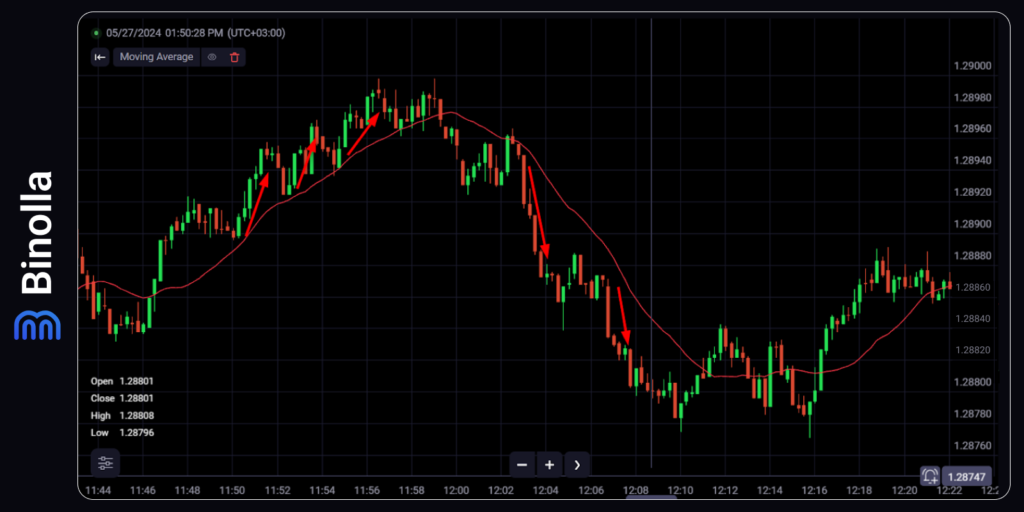The Art of Scalping: Quick Profits and High-Frequency Trading

Traders have a lot of options when it comes to strategies and trading styles. Each strategy boasts its own benefits and risks. Moreover, one should be aware of the basic principles of each approach. Scalping is very popular among digital options and Forex traders. Those who use it, open a lot of trades throughout the day to benefit from small price fluctuations.
The main idea of scalping is to gain small profits and gradually increase the total balance. Those who refer to scalping in their trading sessions must have deep knowledge and understanding of the basic principles of trading. They should also be aware of the current market situation and be experienced enough to make quick decisions. By reading this article, you will delve into scalping and find some interesting strategies. If you are familiar with this style, you can open an account at Binolla and start trading!
Scalping Basics
Those who use scalping in the Forex market focus on one currency or other asset with higher volatility in order to be able to open trades on small fluctuations. For Forex traders, it is crucial to look at trading fees (spreads) as they are going to open a lot of trades and the costs may be significant. When it comes to digital options traders, they have more advantages as there are no spreads at all, which means that you don’t need to think about costs that may grow with the number of trades you open.
Those who are going to trade using scalping strategies should know both sides of this style. Along with profits that one can receive for a series of trades, there are substantial risks of losing as trading on smaller price fluctuations requires a lot of effort and concentration from a trader. One should stick to their trading plan and maintain discipline throughout the whole session in order to succeed.
Scalping stands out from other trading styles. Swing or position traders often hold their trades for days, weeks and even months. Even intraday traders may hold their positions for hours. Scalpers normally do not stay in the market for more than a couple of minutes. However, some trades may last up to a couple of hours if the price movements are very slow. Digital options scalpers are limited in time. Their positions are closed at the expiration.
While profits from separate transactions are minor, the idea is to be able to open dozens of them within a short period of time in order to multiply small gains. Therefore, one needs to have quick reflexes and be able to operate in a stressful environment. Moreover, scalpers should work with a platform with a well-designed interface, which boasts all the necessary technical analysis tools.
Professional scalpers can have substantial gains even by the end of the day. However, one should never forget about the risks that go along with the benefits of this trading approach. For those who trade in Forex, a strict money management strategy should be in place. RIsks of digital options traders are limited by the contract itself.
Scalping vs. Other Popular Trading Styles

Scalping is one of many trading styles offering a trader a lot of opportunities throughout the day. Other approaches have different risk rates and offer various market perspectives.
Scalping
This trading style is one of the fastest ones where traders need to make quick decisions based on their market perception. One of the specific traits of this approach is that a trader should make a lot of trades in a relatively short period. The idea is to generate a lot of small profits. For instance, a market participant can buy EUR/USD at 1.0800 and sell it after a couple of minutes at 1.0805. The profit will be 5 pips only, but if one manages to open ten successful trades in a row, their gains will increase to 50 pips already.
When it comes to digital options, one can capitalize on price fluctuations within 5 seconds. Binolla offers special contracts allowing traders to capture even the smallest movements.
Intraday Trading
Day trading is another style requiring quick decisions in a fast-paced trading environment. It has a lot of similarities to scalping. However, a trader can hold positions for longer and even close them by the end of the day. Digital options intraday traders can set expiration at 4 hours.
A trader can buy GBP/USD at 1.2590 and wait a couple of hours for the price to grow. They decide to close the position when the price reaches 1.2640, which makes 50 pips of profit, which is a relatively good result for two hours of waiting. Similar to scalpers, intraday traders use mostly technical analysis. However, they can also pay attention to news, especially in times of key macroeconomic releases.
Swing Trading
Unlike intraday trading or scalping, swing trading requires holding positions for longer. Some traders may stay in the market for a couple of days or even weeks. Moreover, swing trading implies adding several positions along the trend movement in order to maximize one’s gains. Swing traders still rely on technical analysis, but they can also use key macroeconomic releases or events to improve their trading results.
For instance, if the US CPI data is lower than expected and the EUR/USD price makes a swing at the ascending trendline, one can add a long position expecting the currency pair to grow further. Keep in mind that when using this style, you don’t need to spend much time analyzing the market.
Position Trading
Position traders hold their trades for even longer. They can stay in the market for months waiting for the price to make significant movements in the direction of their positions. They use both technical and fundamental analysis to predict major trends.
Assume that a trader expects the Fed to cut rates by the end of the year. They decide to buy EUR/USD in January at 1.0650. The position is held for several months. When the FOMC announces the rate cut, the price reaches 1.1200 and the trader decides to close the trade.
While this style is less risky, the eventual profits are not as substantial as when one applies other mentioned styles. To capitalize on position trading, one should invest a lot of money (from $10,000) or use high leverage, which adds risks.
Whatever trading style you choose, you should keep in mind that along with its benefits, there are plenty of challenges that you will have to fight with. While scalping allows one to make substantial gains by opening a lot of positions, it requires quick reaction and strict rules together with a well-developed trading strategy.
The Best Strategies that Beginners can Use for Scalping
Scalping is not a strategy itself. It is more of a trading style, allowing traders to capitalize on small price movements and open several positions throughout the day. Here are some of the most trendy tactics that one can use to profit from scalping.
A Stochastic Trading Strategy

The first strategy uses the famous Stochastic indicator to find entry points. Traders need to wait until the price reaches the overbought area (above 70) and then, when two lines of the indicator reverse and go down to cross 70, a trader can buy a Lower contract or sell a currency pair/stock.

The same works for situations when the price leaves the oversold area (below 30). To buy a Higher contract or to buy a currency pair/stock, one needs to wait until the two lines of the Stochastic indicator cross 30 and move higher.

The next strategy that may interest you is based on the moving average indicator. The idea behind it is very simple. When the price tests the MA 20 when the indicator is below it, a trader can buy a Higher contract or buy a currency/stock. On the other hand, when the price tests the line, which is above the quotes, a trader can buy a Lower contract or sell a currency/stock.
Scalping Strategies Based on the Parabolic SAR Indicator

Another strategy that may attract your attention is one with the Parabolic SAR, which is a trend indicator. When the price goes upward and the indicator is below the quotes, one can buy a Higher contract or buy a currency pair. If the price moves downward and the indicator is above the price, then a trader can sell a currency pair/stock or buy a Lower contract.
Tips for Novice Scalpers
Scalping looks very attractive to many traders, including those making their first steps in trading. It offers an opportunity to make substantial gains in a relatively short period. Before making the final decision of whether to add scalping to your trading routine, you should understand whether it aligns with your psychological traits. As it was already mentioned, scalping requires quick decision-making and constant monitoring of the market conditions.
While scalping presents a lot of opportunities, traders should weigh both benefits and drawbacks before involving in this trading style. We are going to provide some key recommendations for those who want to make their first steps in scalping.
Trades Execution
One of the key aspects of successful trading with this style is to be able to find clear entry points. Even a couple of pips may be important as they may separate you from profits. What is even more important is the execution speed, which should be fast enough. For FX traders it is also vital to pay attention to spreads. If a strategy does not allow a trader to catch a clear reversal at the very moment when the price starts growing, then it is better to switch to another method.
Frequency and Costs
This recommendation is important for FX traders. They need to pay attention to trading costs, especially spreads. The high frequency of trades requires one to choose financial instruments with the lowest possible spreads. Otherwise, such commissions may erode gains.
For digital options scalpers, there are no additional costs at all. Binolla traders can simply choose a 5s Scalping contract and buy it.
Trading Strategies
Having a good strategy in scalping is 50% of success. Newcomers should have a reliable trading system that allows them to identify trends and enter the markets in less risky conditions. Scalpers spend much time monitoring markets and finding the best entry points. Trading along the trend allows scalpers to be sure about the general price movement direction. This approach is less risky as trading against the trend may increase losses.
Trading Sides
Newcomers often choose to buy assets, especially stocks as this approach seems to be simple for them. However, it is better to leverage all the opportunities, including short positions. Digital options traders can benefit from any price movement by buying Higher or Lower contracts.
Technical Analysis
Scalpers should equip themselves with technical analysis knowledge. With the rise and quick development of high-frequency trading, it becomes more and more complex to capitalize on small movements. Therefore, one should spend time learning more about the technical indicators they use. Moreover, traders should use technical analysis to find exit points in order to be on time to close their positions. Hapilly, digital options traders are not required to do that as trades are closed automatically at expiration.
Multiple Chart Scalping
Using several charts and timeframes may be of exceptional use to scalpers. Binolla traders can switch between timeframes in order to make sure their decisions do not conflict with the general trend. By finding general trends, traders can be sure that they trade along them as countertrend trading may be very risky. Taking additional risks in scalping is not what you want.
Volume
Scalpers should think about volume when trading. The HIgher volume provides the potential for greater gains as the speed of fluctuations will be higher. On the other hand, trading in a low-speed environment may be less productive.
Discipline
Being disciplined is the key to successful scalping trading. Traders should stick to their strategies and trading plans. If not, they risk turning their profits into losses. Timing is also vital. Professional scalpers never leave their positions overnight as this may introduce additional risks.
The Pros and Cons of Digital Options, Forex, and Stocks Scalping Strategies

Whether you trade FX currencies, stocks, or cryptocurrencies, scalping may bring you both benefits and drawbacks. By reading the following lines, you will see both sides of scalping for the most popular financial instruments and markets.
Forex Scalping
Increased liquidity is one of the key benefits of Forex scalping. The FX market boasts high liquidity allowing traders to buy and sell currency pairs at any time. Another advantage is that the market is open 24 hours five days a week. Forex traders can participate in trading activities around the close five days a week, which allows them to use scalping strategies at any moment. Finally, low spreads is one of the greatest benefits of FX market for scalpers. Most companies offering FX trading services offer tighter spreads for currency pairs, which is advantageous for traders.
When it comes to drawbacks, they include higher volatility, which presents both opportunities and risks, higher leverage that may ruin your balance, as well as the necessity of monitoring the market situation all the time in order not to lose trading oportunities.
Digital Options Scalping
One of the key benefits of digital options scalping is defined risk and reward. You don’t need to think about protecting your trades. Moreover, you know in advance how much you can earn. Another advantage is that those contract are simple to understand. Digital options trading is straightforward. 5s scalping at Binolla allows traders to make gains quickly. Moreover, you don’t need to pay any fees for buying Higher and Lower contracts.
As for disadvantages, digital options are not as flexible as other financial instruments as one can’t adjust their positions once the contact is bought.
Stock Scalping
The advantages of trading stocks using scalping strategies include diverse opportunities as there are a lot of assets to choose from. Moreover, stock traders can take informed decisions especially during earnings reports. With this in mind, traders have a chance to make substantial profits even within short periods.
The drawbacks of using scalping strategies in stock trading may include high transaction costs and limited market hours. Unlike Forex pairs, which can be traded around the clock, stocks are available for a limited period.
All strategies of this type have both their advantages and disadvantages. By weighing them, traders can make informed decisions. Market participants should consider all the features of scalping before placing a first trade.
FAQ

What is Forex and Digital Options Scalping?
Scalping is a special trading style where a trader places a lot of trades in a relatively short period. Market participants should be quick and have good strategies in order to find entry points with a high precision level.
What are the key characteristics of a successful scalper in Forex and digital options?
Successful scalpers are typically highly disciplined, quick in decision-making, and adept at monitoring the markets continuously. They have a strong understanding of technical analysis, use advanced trading platforms for rapid execution, and manage their risk meticulously.
How does the risk management approach differ between Forex scalping and digital options scalping?
In Forex scalping, risk management involves setting tight stop-loss orders to minimize losses on each trade and using appropriate leverage levels. In digital options, risk management is more about controlling the amount invested in each option and understanding that the all-or-nothing nature of digital options requires careful selection of trades to avoid substantial losses.
What Challenges Do Newcomers Face When They Use Scalping Strategies?
Beginners may not have a reliable strategy to make informed trading decisions. Moreover, they may have emotional problems as scalping puts psychological pressure on traders. They should know a lot of technical analysis tools in order to combine them to find the best entry points.
Is It Important to Learn Technical Analysis for Scalping Trading?
Yes, it is. Knowing technical analysis is crucial for scalping. Technical analysis is the only way a scalper can find entry points in digital options. For Forex traders, technical analysis is useful for both finding entries and placing stop losses to protect them from risks.
How Transaction Costs Impact Forex and Digital Options Scalping?
There are no transaction costs in digital options, which makes this tool the best for scalping trading. Forex traders, in turn, should check spreads before engaging. In case of expanded spreads, traders should choose other assets with lower difference between the Ask and the Bid prices.






